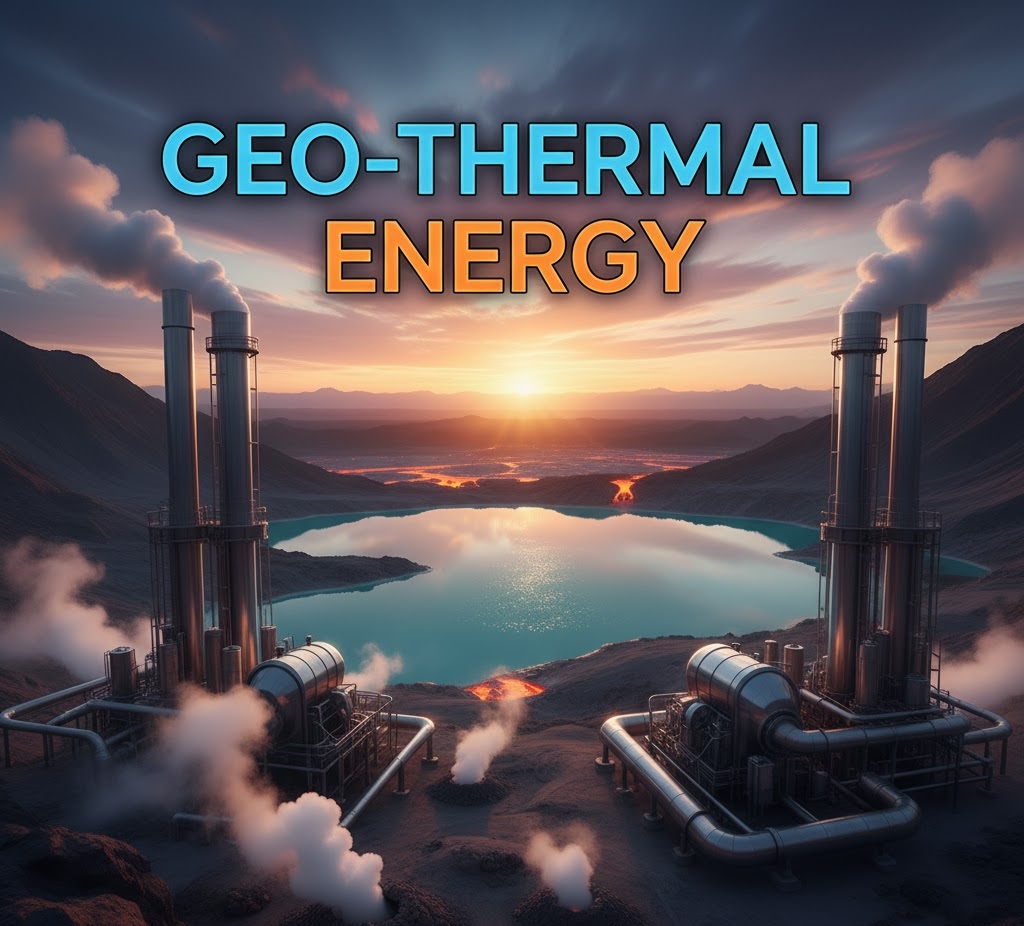Geo-Thermal in Specific Regions & Critical Minerals Extraction
Geo-Thermal energy is derived from the thermal energy that is naturally retained below the Earth’s surface. It is a clean, reliable, and sustainable source of energy that utilizes the interior heat of the planet to produce electricity and direct heating applications.
Additionally, in contrast to wind and solar power, Geo-Thermal power is present throughout the entire year and thus constitutes a steady and renewable energy source. This power is drawn from hot water, steam, and rock reservoirs buried deep inside the Earth, which can be accessed through wells and transmitted into useful energy.
In addition, technological advancements like advanced Geo-Thermal systems have opened up the possibilities of this resource beyond volcanic areas. As the world shifts towards cleaner alternatives, Geo-Thermal energy provides a viable means of breaking free from fossil fuels.
Thus, it is important to understand its process, benefits, and uses to encourage a sustainable and secure energy future.
Geo-Thermal in Specific Regions & Critical Minerals Extraction
Geo-Thermal in Specific Regions
Geothermal energy prospect is extremely varied in the regions with varying geological conditions.
Nations having tectonic plate boundaries, like Iceland, Japan, and Indonesia, make active use of this energy to produce electricity and heat.
Hot springs and volcanic regions in these areas have a ready source of underground heat.
Likewise, geothermal power generation is dominated by the United States, particularly California and Nevada, with a large number of geothermal
reservoirs.
On the other hand, India is also investigating prospective areas in Ladakh, Himachal Pradesh, and the Northeast, where hot springs and steam vents
reveal high geothermal prospecting.
Additionally, countries in Africa such as Kenya and Ethiopia are heavily investing in geothermal ventures in order to address increasing energy needs in an
environmentally friendly manner.
With improving technology, even areas with moderate geothermal gradients can effectively utilize this resource.
Hence, the development of geothermal power in targeted areas can prove to be pivotal in maintaining energy diversity and achieving long-term
environmental objectives.
Understanding the Link Between Geo-Thermal Energy and Critical Minerals
Geothermal energy and critical minerals are intimately related by the natural processes of the Earth.
Since geothermal systems draw out the hot subsurface fluids of the planet, they tend to transport valuable minerals like lithium, manganese, and rare earth
elements to the surface.
These minerals are crucial for battery production, electronics, and renewable energy technologies.
Further, in contrast to conventional mining, it is cleaner and more sustainable to extract minerals from geothermal brines.
It reduces carbon emissions and minimizes land disturbance while producing both materials and energy.
Additionally, the dual-use strategy increases the economic benefits of geothermal projects, making them more investment-ready.
As the demand for critical minerals and clean energy increases, this synergic innovation presents an attractive solution to facilitate global energy
transitions.
Hence, recognizing this connection enables policymakers and industries to embrace wiser approaches to sustainable resource exploitation.
Global Hotspots: Areas with Abundant Geothermal and Mineral Resources
Throughout the globe, a number of areas are particularly notable for their wealth of geothermal energy and valuable minerals.
Nations around the Pacific Ring of Fire, like Indonesia, the Philippines, and Japan, enjoy the riches of active volcanic fields that produce enormous
geothermal heat.
Additionally, these same areas tend to harbor mineralized brines containing lithium and other rare earths.
Concurrently, Iceland and New Zealand have used geothermal power for decades, demonstrating the capability of natural heat to drive homes and
industries without harming the planet.
In North America, the United States, and especially Nevada and California, holds huge potential in putting geothermal energy together with lithium
production.
Kenya and Ethiopia in East Africa are equally fast emerging as leaders in geothermal power, which brings clean energy, and economic development at the
local level.
With technology evolving, these world hotspots underscore how geothermal systems can concurrently address the world’s increasing demands for energy
and minerals effectively and sustainably.
Iceland and the Pacific Ring of Fire: Powerhouse Regions of Nature
Iceland and the Pacific Ring of Fire are two of the strongest geothermal regions on our planet.
Iceland, which sits on top of the Mid-Atlantic Ridge, taps its volcanic energy to generate almost all of its power and heating from hydro and geothermal
resources.
Furthermore, its achievement proves that natural energy can fuel a whole country sustainably.
In contrast, however, the Pacific Ring of Fire, which runs through nations such as Japan, Indonesia, and the Philippines, is faced with incredibly high
geothermal potential because it has high tectonic and volcanic activity.
These countries actively harness underground hot water and steam to produce clean energy as they probe mineral-rich geothermal brines.
To add to this, continuing technological improvements facilitate easy access to deeper heat reservoirs and extraction of essential minerals with reduced
costs.
Hence, both the Pacific Ring of Fire and Iceland are the epitomes of how nature’s force can promote energy security and economic development hand in
hand.
India’s Emerging Geo-Thermal Locations: From Ladakh to the Northeast
India is increasingly tapping its geothermal resources, and locations such as Ladakh, Himachal Pradesh, and the Northeast have been particularly
promising.
The Puga Valley in Ladakh, for example, has been recognized as the nation’s “geothermal capital” because of the active hot springs and elevated
subsurface temperatures.
Additionally, pilot studies here are geared towards generating clean, constant electricity even in tough weather conditions.
In Jharkhand and Himachal Pradesh, geothermal regions ideal for small-scale power and heating purposes have been identified by scientists.
Natural hot springs in Arunachal Pradesh and Meghalaya also show high untapped energy potential.
These also come at a time when India is making an effort to diversify its renewable energy sources away from solar and wind.
With further research, investment, and cooperation, India can soon convert its geothermal resources into a stable repository of sustainable power.
Thus, the country’s upcoming geothermal locations constitute a forward-looking move toward a cleaner tomorrow.
Geo-Thermal Brines: A Secret Source of Lithium and Rare Earth Elements
Geothermal brines are becoming a secret treasure for the new energy age.
These naturally warm underground liquids, which contain dissolved minerals in solution, represent a renewable means of harvesting precious elements
such as lithium, manganese, and rare earth metals.
Additionally, these minerals are essential for manufacturing batteries, electric cars, and clean energy technologies.
In contrast to conventional mining, geothermal production deploys the same hot fluids utilized for energy production, hence making it environmentally
friendly and efficient.
Additionally, nations like the United States, Germany, and Japan are leading initiatives to recover lithium directly from geothermal brines.
This novel process minimizes environmental pollution while catering to the global supply needs of critical minerals.
As the globe moves toward renewable power and electric transportation, geothermal brines offer a twofold opportunity—to generate clean energy and vital
materials at the same time.
Thus, they represent the future of sustainable energy and resource stewardship.
Technological Improvements in Geo-Thermal -Based Mineral Mining
Technological developments of the past few years are revolutionizing geothermal-based mineral mining into a more efficient, sustainable method.
Engineers are now employing improved drilling technologies to access deeper reservoirs of geothermal resources, which were earlier out of reach.
Additionally, membrane separation and ion exchange developments enable minerals like lithium and rare earth elements to be extracted directly from
geothermal brines with less damage to the environment.
Furthermore, sensor and artificial intelligence-installed real-time monitoring systems maximize the process of extraction, resulting in greater yield and
lesser energy utilization.
The United States, Germany, and Japan are spearheading pilot projects where these technologies show their ability to merge energy production and
mineral recovery.
Closed-loop systems are also being engineered to recycle geothermal fluids, minimizing the use of water and increasing sustainability.
As a result, these technological advancements not only make geothermal projects economically viable but also aid in world transition toward clean energy
and vital mineral security.
The Future of Sustainable Energy and Mineral Security Through Geo-Thermal Development
Geothermal development is redesigning the future of sustainable energy and mineral security globally.
With evolving technology, nations are able to tap into underground heat for not just electricity and heat but also the extraction of strategic minerals such as
lithium and rare earth elements.
In addition, combining geothermal energy with mineral recovery lowers reliance on environmentally hazardous mining and fossil fuels, putting a cleaner
and more secure energy infrastructure in place.
Furthermore, research and infrastructure investment is opening up new areas of geothermal potential, from India’s Ladakh to East Africa and beyond.
Finally, policymakers are increasingly acknowledging geothermal’s dual advantage, which pairs energy security with sustainable supply of renewable
technologies’ critical minerals.
As a result, this strategy promotes climate objectives worldwide and promotes economic growth and innovation.
Thus, geothermal development is the pillar of a climate-resilient, low-carbon future that provides both clean power and strategic mineral assets for
generations.
“From Waste to Wonder: The Power of Recycling in Carbon Footprint Reduction”
Geo-Thermal with Other Renewables / Hybrid Systems Integration
Blending geothermal power with other renewable resources is changing the manner in which we generate clean electricity.
Coupling geothermal with solar, wind, or hydro systems, electricity providers can form hybrid configurations that provide day and season-round consistent
and reliable electricity.
In addition, hybrid systems maximize resource utilization through the matching of occasional sources such as solar and wind with the constant base-load
energy of geothermal power.
For example, combining geothermal with solar panels enables excess energy from the sun to be either stored or utilized to support geothermal production,
cutting operating costs.
In addition, sophisticated control technologies and smart grids enable the synchronization of several energy sources smoothly, maximizing output and
stability.
Thus, these hybrid systems not only contribute to energy security but also minimize carbon emissions and environmental footprint.
Thus, combining geothermal with other renewables is a visionary approach to a resilient, low-carbon, and sustainable energy future.
Direct Use Applications & Geo-Exchange / Heat Pump Systems
Direct use applications and geo-exchange systems illustrate the ways that geothermal energy can efficiently and sustainably make a contribution to
everyday life.
For example, geothermal heat pumps offer constant heating and cooling of residential, commercial, and industrial buildings by transferring heat from the
ground to buildings.
In addition, geothermal resources are used directly to heat greenhouses, aquaculture farms, and district heating systems, lessening the reliance on fossil
fuels and lowering operating expenses.
Additionally, these systems run continuously year-round, providing a steady energy no matter the weather, as opposed to solar or wind power.
Advances in heat pump technology have also enhanced efficiency and cost-effectiveness, making geothermal alternatives more viable for communities.
Therefore, integrating geo-exchange systems with renewable energy measures maximizes total energy performance with reduced environmental concern.
Thus, direct use developments and geothermal heat pumps are sensible, economical, and environmentally friendly mechanisms to utilize Earth’s natural
heat towards a sustainable future.
Geo-Thermal in Specific Regions & Critical Minerals Extraction
Conclusion
Summing up, realizing the connection between geothermal power and critical minerals underscores the vast potential of this natural resource.
In addition, international hotspots illustrate how countries with high geothermal activity, like Iceland and the Pacific Ring of Fire, can effectively integrate
energy production with mineral mining.
Likewise, India’s new geothermal areas, from Ladakh to the Northeast, reflect the nation’s increasing ability to utilize clean energy sources in a sustainable
manner.
Further, geothermal brines represent a concealed source of lithium and rare earth elements in favor of the shift to renewables.
Improved technology in geothermal-based mining further supports efficiency and environmental integrity.
Additionally, dual use of resources provides valuable environmental and economic advantages, facilitating both energy security and sustainable
development.
Combining geothermal with other renewables in hybrid systems enhances reliability and minimizes carbon emissions.
Hence, the future of secure and sustainable mineral supply and energy hinges more and more on strategic geothermal development, so it is a pillar of a
clean, resilient, and prosperous future.





0 Comments